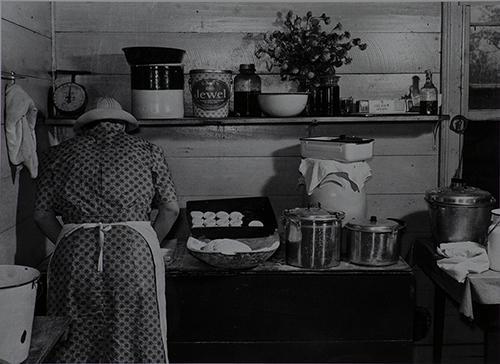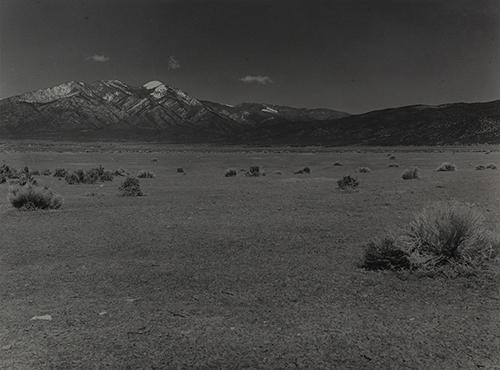Creating the Art Exhibition Experience Online
Students in Andrea Pappas’ Art History course explored Jesuit values while creating virtual exhibitions in partnership with SCU’s de Saisset Museum.
by Sarah Stoddard '23
While teaching her ARTH 140 course, Photography in the United States, Andrea Pappas (Art and Art History) had to get creative for her students’ final projects. Since this course occurred during the COVID-19 pandemic, assigning a typical project that required students to interact in-person with a local art exhibition was impossible. Instead, Pappas had her students create their own virtual exhibitions. With the help of Lauren Baines, the interim director of Santa Clara University’s de Saisset Museum, Pappas and her students created seven virtual exhibitions that exemplify Jesuit values and showcase the students’ creativity and skills.
Pappas began the project by selecting sixty photographs from the de Saisset’s permanent collection for her students to work with. Students were split up into seven groups with each group choosing a theme along with six to ten photographs that aligned with that theme. “Santa Clara students are very concerned about issues of social justice, so a lot of the themes got built around that,” Pappas explains. “A couple of the groups also really focused on the impact of the pandemic.” In their concern for social justice and the issues surrounding the pandemic, the students brilliantly showcased Santa Clara’s Jesuit values, specifically those of standing with the marginalized and taking action to address social problems.

Students completed all the preparation necessary to create their exhibitions, from researching their photographs to writing essays on their themes. One of their most difficult tasks was writing exhibition labels for each photograph they chose. Ryan Nazari ’21 (Philosophy and English) describes the challenge of learning to write these labels. “Through essays and arguments, I usually have to analyze texts very thoroughly, but in exhibitions, I had to form more modest kinds of analysis so the viewer could be the ones to form the interpretations of the photos,” he says. “I also learned to write eloquently (through proofreading and sentence-to-sentence level concerns) to make the reading experience, and thus aesthetic experience, as approachable as possible.”
Of course, the virtual exhibition experience lacks several important features of physical art exhibitions. “At a basic level, an exhibition requires objects, textual information, and a mode of communication for that textual information,” says Baines. These elements are achievable in a virtual space even if they are in a different format. However, the viewer’s experience of them will be different. “Then, you need to make decisions about the display and presentation of those objects and communication media,” Baines continues. Because the viewer encounters the object virtually, rather than in person, their experience of it is altered. Additionally, without the ability to arrange different objects throughout a physical space, the creators of the exhibition won’t be able to dictate the order in which people view the art pieces. “There is a conversation and rhythm, or pacing, that is created in the physical layout of the gallery installation that is difficult, or at least different, than what you can achieve online,” Baines says.
The virtual exhibitions may not have replicated the full extent of a physical gallery, but students carefully curated their webpages to promote a valuable experience. Additionally, Pappas challenged her students to create “Envisioned Installation Layouts” to demonstrate what their exhibition would’ve looked like in a physical setting. “When you walk into a museum, the objects are put next to each other, or across from each other, or in your sightline in the next room, in order to get you to see certain kinds of relationships,” Pappas explains. She wanted her students to consider these relationships; having them create a vision of what their exhibition would’ve looked like in-person allowed them to do so.

Overall, this project was a valuable learning experience for the students in ARTH 140. They learned the intricacies of creating an art exhibition as well as how to collaborate with a group and produce a meaningful project. Kelsey Elinski ’22 (Art History and Psychology) explains the new perspective she gained during this course. “When you're walking around a museum, you don't realize the extent to which everything around you was subjectively crafted together,” she says. “With this in mind, I think this experience has enriched my future museum-going endeavours.” Another student, Noah Sonnenburg ’21 (Communication), describes that it was remarkable to see the unique path each group took with the materials they were given. “Each exhibition was wildly different from the others,” he says. “It shines a light on the value of the individual; each and every person brought their individual insights to the table and the result was incredible.”
Overall, Pappas created a final project for her students that not only allowed them to gain important knowledge about art exhibitions and the history of photography, but also showed them a new way to interact with art that they will carry into their future art-viewing—whether in-person or online. This experience gave the students a chance to express their dedication to addressing and solving issues of social justice. Showcasing Jesuit values through their concerns, they intricately wove their ideas and perspectives into each of their projects, creating something truly valuable beyond the scope of the classroom.
The virtual exhibitions are available for viewing on the de Saisset’s website.